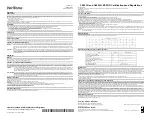
2. Technical Description
16
Specific Features
HX3040
Addressable input variables memory (%I)
96 Kbytes
Addressable output variables memory
(%I)
96 Kbytes
Symbolic variables memory
6 Mbytes
Retain symbolic variables memory
8 Kbytes
Persistent symbolic variables memory
4 Kbytes
Redundant Variable Memory
512 Kbytes
Program memory
12 Mbytes
Source code memory (backup)
100 Mbytes
User files memory
32 Mbytes
Maximum number of tasks
32
Maximum number of expansion racks
8
Ethernet TCP/IP local interface
6
Ethernet TCP/IP interfaces redundancy
support
Yes
CPU redundancy support (same rack)
Yes
Clock synchronization (SNTP)
Yes
Table 2-3. Specific Features
Notes:
Addressable input variables memory (%I):
It is the area where all the direct addressable input
variables are assigned. An addressable variable means that the variable can be accessed directly in
the memory using the desired address. For example: %IB0, %IW100. Addressable input variables
can be used for mapping analogic or digital input points. As a reference, 8 digital input points can be
represented by one byte and 1 analogic input point can be represented by two bytes.
The Hadron Xtorm Series HX3040 CPU defines all the area of addressable input variables memory
(%I) as redundant variables, which means that the user does not need to select this area.
Addressable output variables memory (%Q):
It is the area where all the addressable output
variables are assigned. An addressable variable means that the variable can be accessed directly in
the memory using the desired address. For example: %QB0, %QW100. Addressable output variables
can be used for mapping analogic or digital output points. As a reference, 8 digital output points can
be represented by one byte and 1 analogic output point can be represented by two bytes.
The Hadron Xtorm Series HX3040 CPU defines all the addressable output variables memory (%Q)
as redundant variables, which means that the user does not need to select this area.
Symbolic variables memory:
It is the area where the symbolic variables are assigned. Symbolic
variables are IEC variables created in POUs and GVLs during the application development, not
addressed directly in memory. Symbolic variables can be defined as retain or persistent. In this case
the retain symbolic variables memory or the persistent symbolic variables memory area will be used,
respectively. The RTU system allocates system variables in this area, so that the available space for
the allocation of variables user-created is lower than those reported in the table. The amount of
memory occupied by these system variables depends on the project characteristics (number of
modules, drivers, etc. ...), so it is recommended to observe the available space in the MasterTool
Xtorm compilation messages.
Retain symbolic variables memory:
It is the area where the retain symbolic variables are assigned.
Retain data keep their respective values even after a power on/power off cycle of the CPU. The
complete list of when retain variables keep their values and when the value is lost can be found on
the table below.
















































